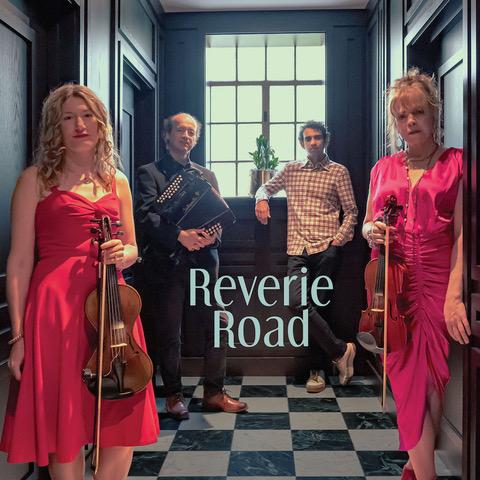June 6, 2024

Reverie Road • When these folks formed up about two years ago, you knew the result was going to be pretty darn good: accordionist/flutist John Williams and fiddler Winnie Horan – two of the co-founders of Solas – along with fiddler Katie Grennan (formerly of Gaelic Storm) and Utsav Lal, the oft-described “raga pianist” and one-time New England Conservatory student. Suffice it to say, “pretty darn good” doesn’t begin to do justice to their work: This album is brimming with imagination, passion, grit, and fun, and governed by a fundamentally good sense of how to fit together these splendid individual talents. There is, of course, a strong traditional Irish component to Reverie Road’s sound, but other influences and interests are evident, including French, Shetland and chamber music, among others.
Horan and Grennan are often the quartet’s linchpins, in unison or in harmony, whether playing the melody – such as “Hardiman’s Fancy” on the “Gap of Dreams” track, and the blazing “Flooded Road” medley (Jimmy McHugh’s “Flooded Road to Glenties,” Ed Reavy’s relentless “House of Hamill” and “New Mown Meadow”) – or giving rhythm or providing textures and ambience. Which is not to downplay Williams' contributions on box, such as on “Megan McCann’s” at the end of the “Emma’s Reel” set or Joe Carey’s “An Siocán Sneachta” in the middle of the “Snowy Drifts” track. Those previously unaware of his prowess on flute (raises hand meekly) will be especially impressed to hear it during, for example, “Snowy Drifts” and “Flooded Road.” It also bears mentioning that Grennan plays mandolin on two tracks and tenor banjo on a third.
Which brings us to Lal, who has often remarked on the connections and commonalities he sees between Celtic and Indian musical forms, notably the “blurred lines” between composition and improvisation in those traditions. Even as he’s played with Celtic performers such as Martin Hayes and Dennis Cahill, Jarlath Henderson and Adam Sutherland, Lal has continued to refine the Indian, jazz and classical elements of his music, all to great effect here.
His pensive solo take on the air/song “The Rocks of Bawn,” with Horan’s subtle backing, is easily a highlight of the album, while also serving as a prelude of sorts to the track that follows, “The Calico Set”: As the piano’s resonance slowly ebbs, the fiddles hold a long note, then Horan eases into the reel “Tear the Calico” (known in some versions as “The Fair Wind”), Lal re-entering quietly, followed by Grennan’s banjo. At length, the fiddles do a slow swell again, this time into a crescendo, and then tear into a pair of masterful Horan originals, “Joe Horan’s” and “Molly Mae’s.”
For good measure and contrast, the album also includes a slowed-down Shetland jig, “Naked and Bare”; a pair of waltzes, “Très Elégante,” by Pennsylvania contra dance pianist Bob Paquarella,” and “Valse pour Yvette” by Sébastien Lagrange”; and the mazurka “Le Femme De Marbre” by the late highly regarded French diatonic accordionist Stéphane Delicq (known in some circles as “The King of The Asymmetrical Waltz").
The Reverie Road roster is bolstered by guest appearances from Donogh Hennessy (guitar), Chico Huff (bass) and Steve Morrow (bodhran).
While the attention to detail in the arrangements is impressive, nothing feels constrained or hemmed-in – there’s plenty of energy and effervescence throughout the album. Reverie Road is the avenue for an uncommonly enjoyable excursion. [www.reverieroadmusic.com]

Lúnasa, “Live in Kyoto” • The first release in six years for this justifiably celebrated, continually innovative band, known for its layered, harmonically sophisticated, exquisitely arranged brand of Irish music, is something of a back-to-basics album. Following their 2013 live recording with the RTÉ Concert Orchestra, “Cas” (2018) saw them collaborate with five different guest vocalists – Daoirí Farrell, Natalie Merchant, Tim O’Brien, Eric Bibb and Mary Chapin Carpenter. Here, it’s just the guys by themselves, and their version of “back to basics” is an absolute pleasure.
Part of the reason is the sense of immediacy conveyed via a live album, especially one recorded in a small venue – Taku Taku in Kyoto – and all the better when you’ve got folks like Ed Boyd (guitar), Kevin Crawford (flute, whistles), Trevor Hutchinson (double bass), Seán Smyth (fiddle, low whistle) and Cillian Vallely (uilleann pipes, low whistle) at the height of their individual and collective powers. Not only that, the material is all new for the band, even if a few tunes have appeared on members’ solo or duo recordings.
For starters, there’s the starter: The first track, “The Bull’s March,” begins with a slow-rocking intro by Boyd and Hutchinson, before Vallely’s pipes take up a traditional 4/4 mixolydian march from Donegal (and possibly elsewhere), “March of the Min na Toitean Bull” – conveying the boldness and swagger of the titular animal – as Smyth and then Crawford join in, the latter playing harmonies on the B part. The quintet seamlessly shifts rhythm and tone in the segue to “40 March” by Niall Vallely (brother of Cillian), and then Boyd redirects the tempo and time signature to jumpstart another Niall Vallely piece, “40 Reel”; Boyd and Hutchinson drop out for the third and final turn through the A part, leaving bare the gorgeous harmony among Cillian Vallely, Smyth and Crawford, before returning for the last B part.
Cillian Vallely’s own credentials as a superior tunesmith, meanwhile, are evident on “Rock Road,” a trio of two intricate slip jigs and a reel ("Windmill Hill/The Seven Houses/Rock Road"). His “Drumcairn” is the middle part of a lengthy track, “John McGinley’s,” that showcases Crawford’s prodigious ability on whistle, as he starts off the proceedings with the haunting air “Liam O’Raghallaigh”; the accompaniment by Boyd and Hutchinson (who bows instead of plucks the bass here) is spare but elegant. Crawford, not so incidentally, displays his own compositional strengths on “Days Around Lahinch/Man from Moyasta,” in duet with Vallely’s low whistle.
No intent to overlook Smyth: He does an outstanding rendition of “The Blue Fiddle,” a 3/4 “slip polka” written by Steve Cooney, and he helps in no small way to rhythmically anchor a glorious set of three Breton tunes. Smyth also kicks off the last track – which highlights Lúnasa’s brilliance in putting together its sets – with “Union Street Session,” a reel written by Cape Breton fiddler, composer and retired lighthouse keeper Paul Cranford; this leads to “Boys of the 25” – a traditional tune particularly favored in Co. Fermanagh – then finishes up with Crawford’s “Cabin in the Woods.”
No telling yet what Lúnasa’s next recording might be, and whether it will involve guest performers or a particular theme or focus. But what “Live in Kyoto” demonstrates beyond any shadow of a doubt is that, wherever their explorations take this band, the pillars on which Lúnasa is built – superlative musicianship, taste and craft – remain as strong as ever, and are its defining assets. [www.lunasamusic.com]

